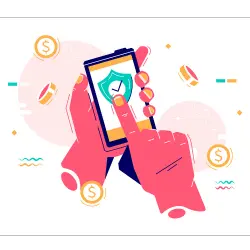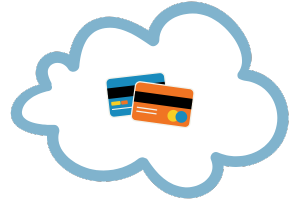TABLE OF CONTENTS
- How to Take Payments Over the Phone in 4 Steps
- Pros & Cons of Accepting Credit Card Payments Over the Phone
- How Much Does It Cost to Take Card Payments Over the Phone?
- Best Practices When Taking Credit Card Payments Over the Phone
- Is it Safe to Accept Credit Cards Over the Phone?
- How to Prevent Fraud & Chargebacks for Over-the-Phone Payments
- How to Get Started Taking Card Payments Over the Phone
- FAQs About Over-the-Phone Payments

In today’s world, businesses are increasingly accepting credit card payments over the phone. These types of transactions are categorized as card-not-present (CNP) and offer merchants an alternative way to accept card payments.
Most businesses now use eCommerce payment gateways for online CNP payments, but what about accepting payments over the phone? If a customer wants to pay for a product or service over the phone, virtual terminals and other software now make it easy to facilitate MOTO (mail order telephone order) transactions.
However, CNP payments offer a range of additional challenges and requirements. Evidence suggests that card-not-present transactions account for around 80% of fraud, making it a vulnerable offering for several businesses.[1]PCBB. “CNP Is Responsible For 80% Of U.S. Fraud“. Accessed June 23, 2023. So, while accepting over-the-phone payments may benefit business owners, it’s also important to employ chargeback prevention tools to reduce fraud exposure.
This guide explores how to accept credit cards by phone, the advantages of accepting MOTO payments, and how to protect your business from payment fraud. Continue reading to unlock the various benefits of accepting payments over the phone!
How to Take Payments Over the Phone in 4 Steps
Modern payment technology allows businesses to easily accept payments over the phone. In many cases, processing MOTO card transactions will only take a few moments. Below, let’s explore a step-by-step guide for accepting over-the-phone payments within your business:
1. Determine the Method You’ll Use to Take Payments Over the Phone
Fortunately, there are three primary options for accepting credit card payments over the phone. Choosing the best one will help you reduce costs and exposure to fraud. Let’s explore the three methods below:
Keying information into a virtual terminal
One of the most effective ways to accept over-the-phone payments is through a virtual terminal. A virtual terminal is a digital portal for accepting payments that operate similarly to a payment gateway. With virtual terminals, merchants can access Level 3 Processing, which captures additional payment information, making it more secure. Not only does this reduce exposure to fraud, but it also lowers interchange fees, ensuring it’s more affordable to merchants.
Keying information into a card terminal
Many card terminals allow merchants to manually key in credit card numbers, CVV codes, and expiration dates. This is a tool commonly used when a customer’s card is damaged or refuses to scan, but it’s also helpful for over-the-phone payments.
Keying information into a mobile payment app
There are now mobile payment apps that allow merchants to key in customer credit card information for payments. This is becoming a popular feature among several payment service providers (PSPs), and while it doesn’t offer the same cost-saving benefits as other virtual terminals, it’s very convenient.
2. Figure Out What Card Information You Need to Collect Over the Phone
Next, it’s time to determine what information you should collect from your customer to process the transaction. In most cases, you will need the following information at the minimum:
- CVV code
- Card expiration date
- Full credit card number
Some virtual terminals also require a full name and billing address. Likewise, it’s worthwhile to collect a customer’s billing and shipping information when you process a MOTO payment, even if your specific method doesn’t require it. Comparing billing and shipping addresses is a valuable tool for spotting suspicious transactions, as separate billing and shipping addresses may be evidence of fraud.
3. Input Your Customer’s Card Information
Once you figure out the information your MOTO payment method requires, it’s time to receive the details from your customer. As you enter the information into the virtual terminal, make sure to double-check with your customer that all details are correct. A single incorrect piece of information will lead to a payment rejection.
4. Submit the Order and Send the Receipt to Your Customer
Lastly, submit the order for payment processing. As with any other type of credit card processing, your business will receive a payment approval or rejection immediately. Next, email your customer the receipt to ensure they have the transaction record.
Pros & Cons of Accepting Credit Card Payments Over the Phone
As with any payment type, there are advantages and disadvantages associated with accepting payments over the phone. Understanding how these particular pros and cons impact your business will help you determine if it’s a worthwhile payment option for you. Let’s explore the specific benefits and drawbacks in more detail below:
Pros
- Payment flexibility
Accepting MOTO credit card payments makes shopping at your business more convenient for customers. Considering American consumers are 63% more likely to shop at businesses that offer their preferred payment method, accepting over-the-phone payments can help you access more customers.[2]CIO. “Consumers Want More Payment Flexibility in Their Shopping Experience“. Accessed June 23, 2023. - Smoother sales funnel
Abandoned carts are a huge issue for online businesses, but what about shoppers who call about products or services and don’t follow through with a purchase? If you want to convert sales over the phone, you need to offer immediate payment options to your customers. For instance, some businesses send payment links or automatic invoices to ensure that they don’t lose contact with customers during the sale process. - Improved cash flow guarantees
Instead of waiting for customers to visit a physical storefront to pay bills, over-the-phone payments ensure that merchants can accept payments at the time of their orders. This helps reduce exposure to uncollected orders, increase payment times, and more. Whether you’re a catering business accepting large payments over the phone or a manufacturing company selling expensive products, MOTO payments reduce exposure to gaps in cash flow. - No need for a physical storefront
While many businesses accepting over-the-phone payments operate brick-and-mortar locations, it isn’t a necessity. MOTO payments allow businesses to operate remotely from call centers, offices, or even their own homes. So if you’re looking to cut down on retail space, all forms of card-not-present transactions are valuable tools.
Cons
- Increased chances of credit card fraud
With more than 380,000 reports of USA-based credit card fraud in 2021, scammers have become a big problem for business owners. [3]Credit.com. “Credit Card Fraud Statistics Everyone Should Know in 2023“. Accessed June 23, 2023. As previously discussed, card-not-present fraud accounts for the majority of credit card fraud, as scammers can use an individual’s card number without possessing a physical card. This type of fraud often results in chargebacks, and chargebacks often result in money out of your pocket. In fact, too many chargebacks can lead to business account closure. Not to mention, while chargebacks frequently require merchants to refund cardholders, most processors also issue chargeback fees. - Increased chances of internal fraud
Not only do MOTO businesses need to worry about external scammers, but they also should be wary of internal employees. As over-the-phone transactions require employees to receive credit card details, there’s always a risk that card information will be stolen. This can cause reputational damage to your business down the line and may even cause data protection liabilities. - Higher processing rates
Lastly, as with all card-not-present transactions, most MOTO transactions cost more than traditional in-person payments. As this type of payment has a higher risk of fraud, processors typically charge more to cover exposure to chargebacks and other potential financial losses. While costs vary depending on your payment provider, it’s important to understand how the higher fees will impact your bottom line. Some businesses choose not to offer MOTO payments due to the increased costs, but for others, it might be worth the risk.
How Much Does It Cost to Take Card Payments Over the Phone?
The cost to accept over-the-phone payments varies depending on your payment provider and your specific business type. If you don’t mind going through the application process, using a merchant service provider will give you the best option for processing fees and allow you to access direct one-on-one support so you can negotiate the best rates for your business.
That being said, to get a general idea of what’s out there, let’s explore some of the CNP charges from a few popular payment service providers:
| Provider | Over-the-Phone Rate (Manual Entry Rate) |
| PayPal | 3.09% + 49¢ |
| Square | 3.5% + 15¢ |
| Stripe | 3.4% + 30¢ |
Remember, PSPs like the ones listed in the above table often charge customers more money than traditional merchant account providers do. So if your business wants to access more affordable rates, consider applying for a traditional merchant account instead.
Best Practices When Taking Credit Card Payments Over the Phone
Employing best practices when taking credit card payments over the phone can help your business reduce fraud exposure, protect customers, and prevent costly issues. Here are some tips to keep in mind while developing your over-the-phone payment procedures:
1. Do Not Record the Call
While your business may record calls for quality monitoring purposes, make sure you don’t record phone payments. Recording phone calls with customers’ credit card information creates a digital footprint of their personal payment details. In doing so, you leave your business open to internal fraud, hacking, or other issues that may lead to the theft of your customers’ credit card details. And this isn’t just a suggestion. In order to stay PCI/DSS compliant, your business cannot record or store any part of a customer’s credit card details.
2. Look Out for Red Flags
As a business owner, it’s wise to keep your eyes peeled for red flags if you accept payments over the phone. If you suspect that someone is misrepresenting themselves, there’s no need to accept a payment from them. Training staff on how to recognize red flags can also help you avoid financial losses. Let’s explore some common red flags below:
- The caller sounds rushed or deceptive: If a caller seems rushed or untruthful, it may be a sign that they’re nervous about using the credit card information. If you don’t have a good feeling about the customer, it’s best to ask for additional payment information or delay the transaction.
- The billing address doesn’t match the shipping address: If a billing address doesn’t match the shipping address, this may be a sign that the individual ordering your products or services isn’t the cardholder. (Although, there are many instances where a legitimate customer could be purchasing a gift for someone else, warranting a different shipping address).
- The caller can’t provide the full details: If a caller cannot provide additional details, such as the phone number or billing address, this may be a sign of fraud. For example, if a scammer purchases stolen credit card information online, they may not have the cardholder’s full details. Avoid customers unwilling to provide the information you need.
If any of the above issues arise, it’s best to delay payment until you can confirm further specifics.
3. Gather All of the Necessary Information
Gathering as much information as possible is a best practice for preventing fraud. With over-the-phone payments, your business is assuming additional risk, so always ensure your customer can provide the information required to prove they’re the cardholder. Here is some helpful information to ask for:
- CVV code
- Cardholder name
- Credit card number
- Credit card expiration date
- Cardholder’s billing address
- Cardholder’s shipping address
- Cardholder’s phone number
Be sure that you don’t store any card details that will put you in breach of PCI/DSS compliance. In some cases, businesses also choose to collect driver’s license numbers and other forms of identification. While this may seem invasive, it’s commonplace when accepting paper checks. Not only does this information help prove the customer is the cardholder, but it can also be used in any subsequent chargeback dispute. Collecting essential information during the payment process is a means of protection for your business.
4. Never Write Down or Store Card Information
Just as your business shouldn’t record the call for security reasons, avoid writing down or storing card information to avoid theft. Storing card information on an internal database will leave your business liable for any hacks or leaks.
Is it Safe to Accept Credit Cards Over the Phone?

Accepting credit card payments over the phone is typical for many United States businesses—it’s a safe form of payment if the proper controls are in place. However, it’s key to understand your obligations for PCI/DSS compliance. Not following proper data management or storing customer card details may result in hefty fines and other penalties for your business.
For this reason, many businesses choose to consult with experts to determine if their payment processes are PCI-compliant. While most processors will provide your business with PCI-compliant payment infrastructure, it’s still your responsibility to ensure that staff members using your payment systems cooperate.
Remember, no credit card payment is 100% “safe.” Scammers will always attempt to use stolen card numbers or file false chargebacks against your business. Using strong internal controls and security-focused payment providers will help reduce exposure to financial harm.
How to Prevent Fraud & Chargebacks for Over-the-Phone Payments
Estimates suggest chargebacks cost U.S. businesses $3.36 for every $1 in fraud, making payment disputes a serious concern for merchants.[4]Firewall Times. “16 Insightful Chargeback Statistics“. Accessed June 23, 2023. While chargebacks are unavoidable for any business accepting credit card payments (especially CNP payments) there are a few tips your business can utilize to reduce their chances. Let’s get started:
Keep a record of fraudulent customers
Keeping a record of dishonest customers helps businesses avoid repeat behavior. For example, if a customer files a chargeback against your business, you may put them on a “no purchase” list to avoid future payment disputes. Likewise, if a specific shipping address is used to commit fraud against your business, making sure you don’t ship products to that address again is highly important.
Use virtual terminals with advanced security features
While keying card information into a traditional terminal is a popular way to accept over-the-phone payments, it’s certainly less secure than using a modern virtual terminal. Virtual terminals allow merchants and payment processors to collect more information from the customer and the transaction, lowering the chances of fraud. Not only is this more safe for your business, but it also lowers your processing fees.
Use tracked shipping
Using tracked shipping and requiring a signature upon delivery helps reduce exposure to fraud. This will provide verification that an individual’s shipping address matches their billing address. Scammers are also less likely to order products and sign for them at real addresses. Additionally, if a customer files a chargeback, you can use the delivery confirmation as proof that the product was received.
List your trading name on your merchant account
Always use your trading name on your merchant account to avoid unnecessary chargebacks. Using a different name may result in confusion for customers as they might not recognize the transaction. This is a helpful tip for all payments, not just over-the-phone transactions.
Collect evidence
While your business isn’t able to store credit card numbers or CVV codes, collecting information about the transaction is still necessary. Order totals, shipping addresses, and other purchase details are all valuable evidence if a chargeback arises. If a chargeback occurs, your merchant account provider will request information about the payment and a chargeback rebuttal letter from you, including all relevant proof of the transaction’s legitimacy.
Train your employees
Lastly, no matter what type of fraud prevention strategies your business employs, ensure that all staff members understand their responsibilities. Provide extensive training on collecting payment details, spotting suspicious behavior, and adhering to PCI/DSS compliance.
How to Get Started Taking Card Payments Over the Phone
As discussed, over-the-phone payments carry additional risks due to cards not being present at the time of sale. However, if your business requires this payment option, find a reliable payment provider with CNP or MOTO credit card processing options. A secure and experienced provider will give you the tools and recourses that you need to keep your business protected from potential financial losses. Some benefits include higher chargeback thresholds, dedicated support, and advanced security features to protect against fraud. So, when you partner with a merchant services provider that has a clear understanding of your industry and its risks, your over-the-phone payments will stay secure!
FAQs About Over-the-Phone Payments
Are you allowed to take payments over the phone?
Yes, merchants are allowed to accept credit card payments by phone, and there are various software solutions to enable the process. However, it’s important to avoid recording calls, writing down card details, or storing card information. Not doing so may result in data leaks, fraud, PCI/DSS compliance breaches, and other liability issues. Similarly, if your business chooses to accept over-the-phone payments, make sure to employ the proper fraud prevention strategies to avoid card-not-present fraud.
What card details should I have my customers give over the phone?
The details your customer provides over the phone will vary depending on the payment method your business uses to process card-not-present transactions. At a minimum, your customer will need their card number, CVV code, and card expiration date. However, some payment methods will require a full name, billing address, and other details.
How should I ask for credit card information from my customers?
First, provide the order total and then request the necessary payment details. There are also other ways to collect payments when a customer isn’t present at a brick-and-mortar storefront. For example, your business can send payment links, allowing customers to complete an invoice payment online. Consider the alternatives if a customer isn’t comfortable providing details over the phone.







